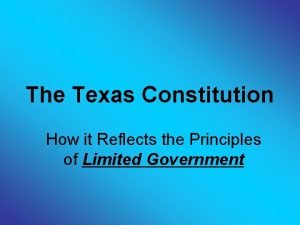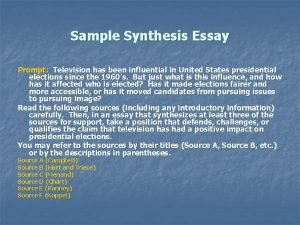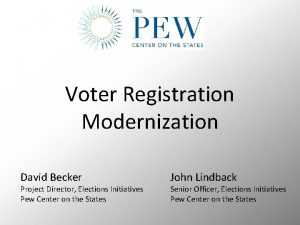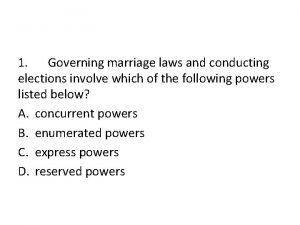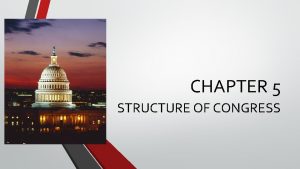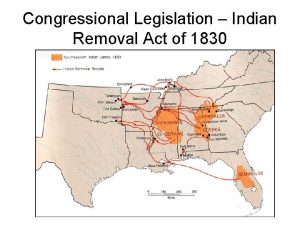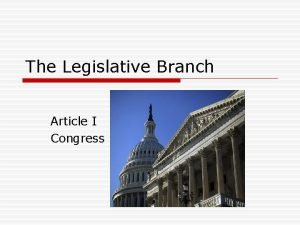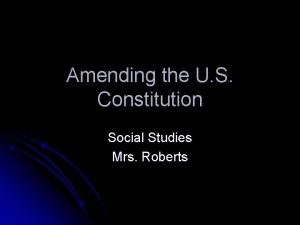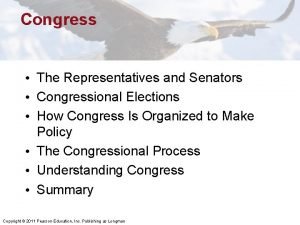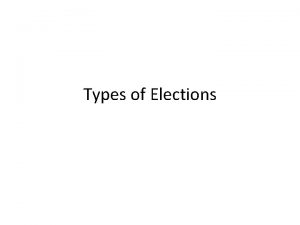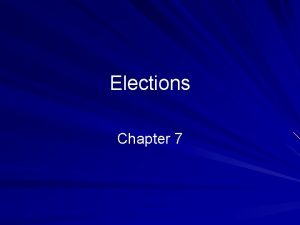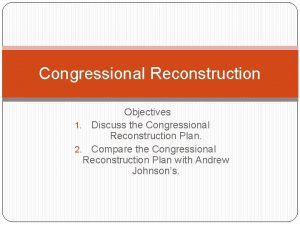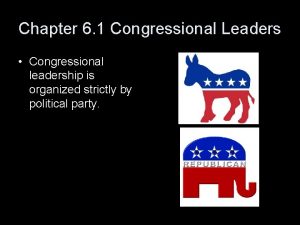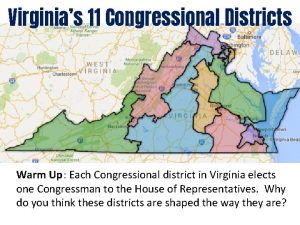Congressional Elections Constitution Senators Up for election every




























- Slides: 28

Congressional Elections

Constitution • Senators – Up for election every 6 years – Originally selected by state legislatures – 17 th Amendment, 1913: Direct statewide election • Members of House of Representatives – Up for election every 2 years – Directly elected by people – Elected from districts

Rules governing election to Congress • The Constitution

Constitution: election to the House of Representatives • • • Election every 2 years Must be 25 years old Citizenship for 7 years Live in the state Selected same way as largest house of state legislature (popular vote) • Apportioned among states based on population

Constitution: election to the Senate • Election every 6 years – Three Classes • • • Must be at least 30 years old Citizen for 9 years Live in the state Selected by state legislatures 2 per state

Rules governing election to Congress • The Constitution • Single-member, winner-take all districts • Reapportionment and redistricting

Reapportionment • When the federal government reallocates seats among the states after the decennial census

Gains and losses due to 2010 reapportionment Losses Gains • • Arizona Florida Georgia Nevada South Carolina Texas Utah Washington +1 +2 +1 +1 +1 +4 +1 +1 • • • Illinois Iowa Louisiana Massachusetts Michigan Missouri New Jersey New York Ohio Pennsylvania -1 -1 -2 -2 -1

Redistricting • When states redraw congressional district boundaries after decennial census • Wesberry v. Sanders (1964) – Each district must have equal population

What criteria should states use in deciding where to draw district lines?

Conflicting Values • • • Contiguity of boundaries (requirement) Equal population (requirement) Compactness Keeping together communities of interest Protecting interests of racial minorities – Meeting requirements of Voting Rights Act • Partisan gerrymandering • Incumbent protection • Maximizing competition

Rules governing election to Congress • • The Constitution Single-member, winner-take all districts Reapportionment and redistricting Primary election laws – Open vs. Closed • FECA

Federal Election Campaign Act (as amended by the Bipartisan Campaign Reform Act of 2002) • Contribution limit (from an individual to a candidate’s campaign) = $2500 • Total cycle contribution limit (from individuals to all candidate and party committees) = $117, 000 • Contribution limit (PACs to each candidate’s campaign) = $5000

How do voters decide? Heuristics: • Party ID • Name recognition • Incumbency!

Sources of incumbent advantage • • Voters recognize their name Gerrymandering Privileges of office Ease of raising money


How do voters decide? • Heuristics • Campaigns

Cost of campaigns • • 2010 Ave. House campaign cost: $1. 1 million Ave. Senate campaign cost: $8. 1 million Incumbents’ ave. expenditures: $814, 507* Challengers’ ave. expenditures: $369, 823* • *As of 2000, ratio similar but numbers higher today. • In 2010, the 78 House candidates in the closest races spent $1. 75 million each, on average. • In 2000, NY Sen. Race cost $69 million.

Total cost of campaigns

Where does money come from?

Where does money come from?

Budget of a typical House campaign

Who gets elected? • White men



Who gets elected? • White men • Lawyers • Christians • Previously elected officials

Small group discussion What constitutes good representation? What characteristics of a representative would make you feel like he or she should do a good job representing you and your interests? What behavior should a good representative engage in? When, if ever, should a representative put his constituents’ interests aside and think of the greater good? You will turn your notes in for participation credit.

Different models of representation • Looking like me, having my background – “Symbolic representation” • Rep. uses own judgment to act on my behalf – “Representative-as-delegate” • Doing exactly what I would do – “Representative as agent” • Communication with me
 What did caesar do that insulted the senators?
What did caesar do that insulted the senators? The constitution lesson 1 principles of the constitution
The constitution lesson 1 principles of the constitution Texas constitution vs u.s. constitution venn diagram
Texas constitution vs u.s. constitution venn diagram Nc constitution vs us constitution
Nc constitution vs us constitution Constitution what is constitution
Constitution what is constitution Every rotarian every year
Every rotarian every year Every country and every nation
Every country and every nation Every nation and every country
Every nation and every country Microsoft's mission statement
Microsoft's mission statement Every picture has a story and every story has a moment
Every picture has a story and every story has a moment Every knee shall bow every tongue confess
Every knee shall bow every tongue confess Every child every day
Every child every day Ap lang synthesis essay television presidential elections
Ap lang synthesis essay television presidential elections David becker elections
David becker elections Stalin promise free elections
Stalin promise free elections “elections are key to democracy”
“elections are key to democracy” African charter on democracy, elections and governance
African charter on democracy, elections and governance Presidential elections exploration and announcement
Presidential elections exploration and announcement Governing marriage laws and conducting elections involve
Governing marriage laws and conducting elections involve Conclusion on elections
Conclusion on elections The organization of congress chapter 5
The organization of congress chapter 5 Development of congressional powers chapter 6 answer key
Development of congressional powers chapter 6 answer key Presidential and congressional reconstruction venn diagram
Presidential and congressional reconstruction venn diagram Congressional act of 1830
Congressional act of 1830 Number of representatives per state
Number of representatives per state Presidential and congressional reconstruction venn diagram
Presidential and congressional reconstruction venn diagram Lesson 4 congressional committees answer key
Lesson 4 congressional committees answer key Restraint on congressional salaries amendment
Restraint on congressional salaries amendment Congressional reconstruction refers to the period when
Congressional reconstruction refers to the period when


